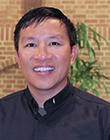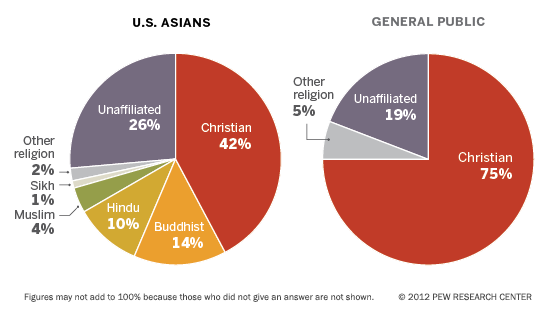Teaching about Asian American Sacred Spaces at a Catholic College
Encountering Unknown Places
“I am nervous going into the temple.”
“I am not sure what to do.”
“What if I make a mistake?”
These statements were uttered by my students as we entered the Hindu Temple Society of the Capital District of New York. The five students had not been in a temple before, knew very little to nothing about Hinduism, and I had presented only a brief introduction on Hinduism during the second week of the semester. When we entered the temple, we immediately saw a sign instructing us what to do. This put many of the students at ease as they proceeded to follow the posted instructions.
|
Mapping Assignment |
The students are part of an introductory class, called Experiences of the Sacred, that I teach at a Catholic college. I had been teaching the course for four years, but in the past two, I incorporated an assignment of having students map religious places. The mapping assignment seeks to understand how place is central to studying religion, especially Asian religions in the diaspora. The assignment consists of three components. First, the students are to search for places of worship from a particular religious tradition within the vicinity of the New York capital, specifically in the towns of Albany, Schenectady, and Troy, where there is a large and growing South Asian American population that reflects increasing religious pluralism.
There are usually twenty-five students in the class, which makes it easy to divide them into five groups of five students. Each group is assigned one of the following religious traditions: Hinduism, Buddhism, Islam, Orthodox Christianity, Sikhism, and Judaism. I do not want them to attend mainline Roman Catholic or Protestant churches since the majority of the students come from these backgrounds. The students are then required to find all of the worship sites of the assigned religious tradition.
Second, they are asked to choose one sacred site to visit at least three times. This was modified from a previous requirement that they were to visit three different places. It was changed because some of these religious traditions had only one or two places of worship. Students must then contact the place and make appropriate arrangements to attend and to learn as much about the place as possible. I accompanied them on the first visit if they wanted me to. Most of the groups chose to go by themselves. Groups that did not feel comfortable were generally the ones visiting Hindu, Buddhist, Sikh, or Islamic places of worship.
Third, the students would engage with the environmental studies department’s class on geographical information systems (GIS) environmental applications to map the places of worship on a grid. My students collected information and then gave it to the GIS students, who would physically go to the area and survey it. My students were also instructed to collect information about the surrounding area, such as shopping centers, businesses, and important landmarks. Since many of these religious traditions were created predominantly by immigrant communities, I wanted students to pay attention to where, when, and how the places of worship developed. They made observations about how immigrant communities, such as Pakistanis, Indians, or Eastern Europeans, created businesses which cater to their cultural traditions. Most of these are near the worship site or within a mile radius of the worship place.
The final part of the assignment is a thirty-minute group presentation discussing their work, collaborating with the GIS students, the process of understanding specific locations of worship, and the surrounding neighborhood.
Finding a Place
My interest in teaching about place in religious studies stems from my own research on migration and religion. Migration may indicate movement, and in some cases, constant movement from one place to another. In contrast, what I found is that migration is about place. It is the process of being in a place, being displaced from that familiar place, and then finally being relocated in another place. This three-fold process is how migration embraces the importance of place. It is also how people find their identity and sense of well being.
Moreover, the discussion of place in theological circles (an area in which I was trained) is minimal to nonexistent. Scant attention has been given to understanding how place is important to the way human beings experience and interact with the sacred. The theological community has only recently turned towards this discussion, and only a handful of theologians have taken up the task of exploring and explaining the significance of place for theology. Hence, I thought that place would be an important exercise for students in their study of religions.
I employ the understanding of place as vital in the everyday lives of young adults. Place is important, especially in a world where so many people are attached to the Internet and where young people only understand something to be “real” once it is uploaded to Facebook. The discussion of space now extends into cyberspace and may give the impression that there is no location or physical groundedness, or that connection can be easily severed at any time. One can be unfriended or eliminated from an e-mail list or be booted out of a chat room with a click of a button. Thus, the domain of cyberspace leads to a structure of disenchantment and even alienation. Cyberspace does not provide location, but suspends lives located somewhere beyond the ethereal World Wide Web. The study and experience of place, on the other hand, would ground students in a physical location as well as in concrete relationships.
For some practitioners, place represents the presence of God and/or gods. The place has become divine and is precisely why it is sacred. Thus, it is important to emphasize how crucial place is in human experiences and relationships, especially at a time in students’ lives when they are in-between places. The religious community can then be witness to the fact that place, now infused with a sacred identity, is important to human existence.
Dwelling in new places
The inclusion of attending a place of worship and mapping its location has helped in teaching students about religious diversity, especially Asian American religious pluralism. Since the majority of my students come from white middle-class Christian backgrounds, many have not experienced other faith traditions. Visits to other places of worship are possible due to the fact that a number of different religious sites now exist in this region of New York State. This gives students an opportunity to see that even in an area once dominated by Christianity, religious diversity in America is continually changing.
Many students discovered that some Asian American places of worship were former Christian churches. These were either converted into Hindu temples, Sikh gurdwaras, or Buddhist meditation centers. Students commented that these changes were consistent with the new immigrant populations that settled in the area. Some neighborhoods were low-income areas of town and others were in affluent areas.
Some of the students groups were able to do demographic research on income levels of neighborhoods surrounding the worship site. Other groups focused on the racial demographics. They researched city records to investigate what the racial and ethnic make up of the area had been historically, and then mapped that data onto their grid. This really enhanced the overall project. One revealing finding my students discovered was that religious diversity of the area was not consistent. For example, while the college is located in a wealthy and white Christian area, Islamic, Buddhists, Hindu, and Orthodox centers were located in more urban and economically challenged neighborhoods surrounded by ethnic restaurants and ethnic businesses.
Once my students became more comfortable with the religious places they visited, they were able to make some observations that are important to studying Asian religions in America. The students made the connection that the Hindu temple and Buddhist meditation centers were similar to the Christian churches they had experienced. That is, these Asian religions seem to take on a congregational feel with weekly attendance, faith programs, and other social activities. They were surprised by the regularity of attendance because in Asia, it is not as regular or strict. They found that Hindu worshippers went regularly to temple, especially since there were weekly classes and weekend services provided by the priests, who resided next to the temple. Some wondered if this was the influence of the American approach to practicing Asian religion. They stated that many Hindu worshippers would stop and ask them if they needed help or an explanation about a certain image or statue. Thus, the students observed how Americans in general seem to want to explain why they worship in a place and that was something they experienced at the temple. These influences on Asian religions in America are something that will need to be further discussed in the class. It was an aspect of teaching that I had not focused on because I was geared towards giving the students a basic foundation about each of these religions. It will be important to study if aspects of the religious tradition have taken on a different experience in a new place.
Finally, mapping a place marks its presence in a community as well as creating a new foundation for understanding and respecting religious diversity. Many students were amazed at the sheer number of diverse religious places within the Capital Region of New York. Some remarked that they had not really thought about the religious worship sites, but would now pay more attention, especially to religious diversity in their own hometowns.
Students come to understand that place is an important part of experiencing the sacred, especially the amount of effort and dedication that many believers put into creating these physical places of worship. The act of learning takes place in place.
 Linh Hoang, OFM, PhD, is an associate professor of religious studies at Siena College in Loudonville, New York. He is also a Franciscan priest with the Holy Name Province in New York City. He has published articles in the areas of Asian American Catholics, Vietnamese Catholicism, globalization, historical theology, and intergenerational religious practices. His book, Rebuilding Religious Experience: Vietnamese Refugees in America (VDM Verlag Dr. Müller), published in 2007, was his doctoral dissertation. He has published articles and chapters in New Theology Review, American Catholic Studies, Horizons, Multicultural Review, Asian Theology Review, and The Catholic Studies Reader. He is currently serving a three-year term as a consultant to the United States Conference of Catholic Bishops on Asian and Pacific Islander Catholic concerns. He is also researching and writing for a book on a theology of place.
Linh Hoang, OFM, PhD, is an associate professor of religious studies at Siena College in Loudonville, New York. He is also a Franciscan priest with the Holy Name Province in New York City. He has published articles in the areas of Asian American Catholics, Vietnamese Catholicism, globalization, historical theology, and intergenerational religious practices. His book, Rebuilding Religious Experience: Vietnamese Refugees in America (VDM Verlag Dr. Müller), published in 2007, was his doctoral dissertation. He has published articles and chapters in New Theology Review, American Catholic Studies, Horizons, Multicultural Review, Asian Theology Review, and The Catholic Studies Reader. He is currently serving a three-year term as a consultant to the United States Conference of Catholic Bishops on Asian and Pacific Islander Catholic concerns. He is also researching and writing for a book on a theology of place.

